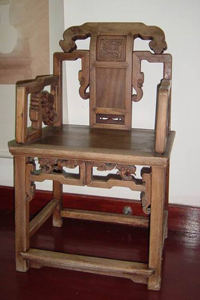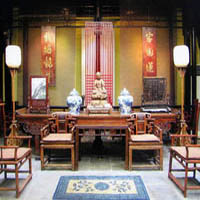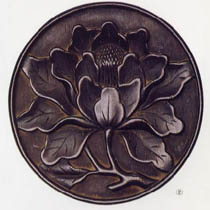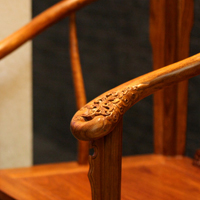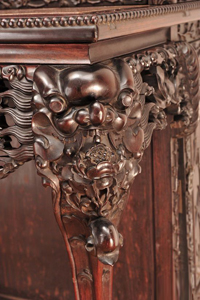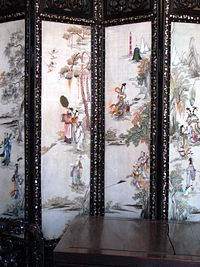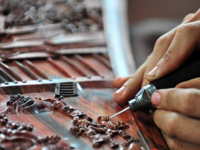
Furniture is part of a convention concerning people's residence. Its design, manufacture and style reflect the spiritual outlook and aesthetic taste of a time. The development of Chinese furniture is linked to changes in people's daily life. Since the Southern and Northern dynasties when Chinese people no more sat on the ground but began to sit on higher chairs, a large quantity of the high household articles like chairs, tables, stools came into use.
| The Ming (1368-1644) and early Qing (1644-1911) dynasties were ages of expansion and great prosperity in Chinese history. The Ming and Qing dynasties were the golden age of Chinese traditional furniture. It not only inherited the tradition of the previous thousands of years, but made breakthroughs. The most sought-after furniture made of the choicest timber was as precious as gold. Ming furniture is treasured for its comfortable design, simplicity and elegance. | | Qing furniture impresses people with its grandeur and pageantry. Though different in style, Ming and Qing furniture represents the zenith of classical Chinese furniture making because of the use of hardwood material and superb craftsmanship. They adopts China's traditional mortise-and-tenon technique. This unique dovetailing, good frame structure and the perfect shapes together make the Chinese classical furniture a combination of practical use and beauty, and of science and art. |
-------------------------------------------------------------------------------------------------------------------------------------
Material more»
| The source of timber largely decides the quality of the furniture. Ming and Qing classical Chinese furniture is no exception. The imported tropical hardwood, mostly from southeast Asia, was the most choice wood for Ming and Qing furniture. Craftsmen in the Ming Dynasty used these valuable hardwoods like sandalwood and rosewood to make furniture for the royal family. | | The purplish-black red sandalwood is hard, heavy, and sinks easily in water. The Chinese have long considered it the most rare timber in the world because it only grows several centimeters in a hundred years. Even today, a Chinese table made of red sandalwood remains a symbol of wealth for most Chinese to have a suite of red sandalwood furniture. | |
| | Timber can be roughly classified into four color-categories in descending order of hardness and value: black, yellow, red, and white. Black stands for red sandalwood; yellow for yellow rosewood; red for blackwood, and white for other ordinary timber. Judging by hardness and density, hardwoods rank among the top. Sandalwood, rosewood, and blackwood are all considered the best. | | |
-------------------------------------------------------------------------------------------------------------------------------------
Features & Types more»
Qing furniture is larger than that of the Ming Dynasty and more imposing, with elaborate carving and inlaid decoration. Both types are prized for their fine materials, special workmanship and high artistic level.
| ♦Comfort and simplicity of Ming furniture | ||
| An important style feature of the Ming furniture is its elegance and simplicity. Simple lines and minimal decoration serve as a foil to the natural beauty of the wood. However, this meaningful simplicity was achieved without compromising comfort. The pursuit of comfort was reflected in such details as curves, lines, height, and size. | height of chairs ranged from 40 centimeters to 50 centimeters, suitable for the legs to drop comfortably. | Superb joinery skills were especially reflected at the joints, where only mortise and tenon, instead of nails, were used. The connected parts of furniture were exclusively tightened with glue made from the swimming bladders of sea fish. This type of natural glue, which was sophisticatedly processed, differed from its chemical counterparts and was health friendly. |
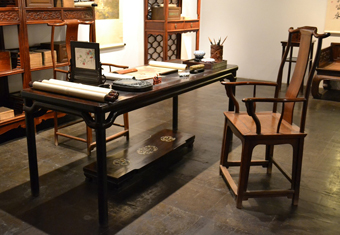 | ||
| iron nail is used in Ming and Qing furniture | ||
| ♦Grandeur and gaudiness of the Qing furniture | |
| Furniture produced during the early Qing Dynasty followed Ming styles and continued to display simple lines. However a change in style gradually appeared in the early 18th century, and Qing furniture showed its uniqueness in larger sizes and overly ornate carvings. Furniture became more elaborate. Straight lines, simple designs gave way to elaborately carved decorations. But it was by no means garish. Engraving and color painting were popular and important means of decorating furniture. The backrest, arms, and legs of chairs were often carved with different patterns. A refined screen panel might have taken ten skillful craftsmen up to several months to complete. Though superb in craftsmanship, Qing furniture sacrificed comfort, designed merely to please the eye. The Imperial "Dragon Chair" was good evidence of this. With the armchairs and the backrest at right angles, the vast chair looks rigid and uncomfortable. It became a symbol of imperial power when the emperor was sitting high on the chair presiding over a court meeting. | |
-------------------------------------------------------------------------------------------------------------------------------------
Background more»
| Ming furniture dates from the end of the Ming Dynasty, a transitional time in Chinese history. During the beginning and the middle of the Ming Dynasty, austerity was a government edict. Later, people had to remain low-keyed about their wealth to avoid high taxes. With the issuance of a policy to lower taxes, people finally found a solution to vent their natural inclinations. The vogue went beyond a rich and decent life; luxury and novelty became the fashion. Under such a social background, people, rich or poor, were free to wear bright and magnificent clothes and to build large houses; consequently, luxurious furniture was needed. No place has collected more Ming and Qing furniture than the Palace Museum in Beijing. Over the long history, the most precious household articles and art works have flowed here from different parts of China. | |
-------------------------------------------------------------------------------------------------------------------------------------
Furniture-Making Centers more»
| | The centers were formed in Beijing, Shanxi, Guangzhou and Suzhou. The ancient Ming and Qing Streets, Qiao's Compound and Wang's Compound in Pingyao, Shanxi, provide a sufficient testimony to the aesthetic and cultural achievement in Jin-style furniture. Chinese Ming and Qing Furniture Gallery of Shanghai Museum is an ideal place to appreciate various styles of classical furniture. In the past 20 years, Ming and Qing furniture has enjoyed an elevated reputation as art and as investment, and its value is increasing. |
-------------------------------------------------------------------------------------------------------------------------------------
Information on collection and purchasing reproductions
Exports of furniture made of yellow rosewood, red sandalwood, ebony, and chicken wing wood, are strictly prohibited, no matter when it was made. Foreigners living in China are allowed to purchase these four kinds of furniture only if they don't take them abroad.
Less than 10,000 pieces of Ming and Qing furniture have been passed down to today. Largely due to its rarity the furniture has witnessed a large price hike over the past few years at auction houses. In the spring of 2006, an embroidered screen panel of the late Qing period was auctioned off in Macau at RMB 85,330,000 (more than $10 million USD), setting a record auction price for Chinese classical furniture.
Although genuine Ming and Qing furniture might not be affordable, people can go to antique furniture markets to buy reproductions. There are dozens of antique furniture markets in Beijing, and Gaobeidian Market, Panjiayuan Market, Lvjiaying Market, and Zhaojiachaowai Market are ranked among the best.
Written by Nicolas Yang
